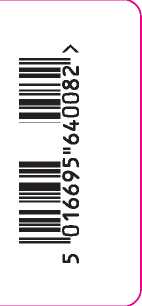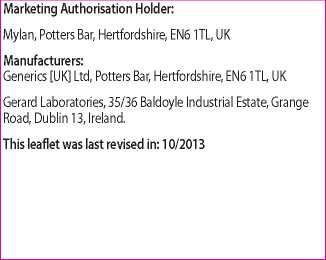Labetalol Tablets Bp 100mg
Out of date information, search another3
17
9
|
r 100 mg |
Labetalol 100 mg Film-coated Tablets |
|
56 film-coated tablets | |
Each film-coated tablet contains labetalol hydrochloride 100 mg. Contains sucrose. For Oral use as directed by a doctor. Read the package leaflet before use.
Keep out of the sight and reach of children.
WARNING: Do not take this medicine if you have wheezing or asthma.
Store in a dry place below 25 °C. Store in the original package in order to protect from light.
PL 04569/0052 IPOMl LL0425AF 639608 Mylan, Potters Bar, Hertfordshire EN6 1TL, United Kingdom
■
Mylan
- If you get any side effects talk to your doctor or pharmacist. This includes any possible side effects not listed in this leaflet. See section 4.
In this leaflet:
1. What Labetalol is and what it is used for
2. What you need to know before you take Labetalol
3. How to take Labetalol
4. Possible side effects
5. How to store Labetalol
6. Contents of the pack and other information.
1. What Labetalol is and what it is used for
Labetalol belongs to a family of medicines known as beta-blockers. Labetalol works by causing the heart to beat slower and with less force. It also widens the arteries in the body.
coughing or worsening of their symptoms.
Rare (may affect up to 1 in 1,000 people):
• a very slow heart beat
Very rare (may affect up to 1 in 10,000 people):
• shaking (in pregnant women)
• worsening of blood circulation problems
Not known (frequency cannot be estimated from the available data):
• or dry eyes
• changes in behaviour, mood changes, feeling depressed or confused, hallucinations
• sleep problems, nightmares
• headache, feeling tired or weak
• a blocked nose
• sweating
cimetidine, to treat heartburn or ulcers anti-inflammatory painkillers e.g. ibuprofen, aspirin, other medicines used to treat pain, or corticosteroids e.g. prednisolone
antimalarial medicines e.g. mefloquine or quinine medicines to treat migraine e.g. ergotamine alprostadil to treat impotence moxisylyte to treat Raynaud's disease, a condition that affects the blood circulation to the fingers and toes aldesleukin for the treatment of secondary cancer of the kidney
hormones such as oestrogen and progesterone used as contraceptives or for hormone replacement therapy Tell your doctor or pharmacist if you are taking, have recently taken or might take any other medicines, including medicines obtained without a prescription.
|
• |
• |
• |
• |
• |
• |
• |
|
• |
• |
• |
• • |
• | ||
|
• |
• |
• | ||||
|
L |
A |
E |
E |
T |
A |
L |
|
• |
• | |||||
|
• |
• | |||||
|
• |
• | |||||
|
• |
• |
• |
• |
• • |
• • | |
|
• |
• • |
• • |
• • | |||
|
• • |
• | |||||
|
• |
• |
• |
• |
• |
• |
• |
|
• • |
• |
• |
• |
• • |
• | |
|
• |
• |
• |
• | |||
|
T |
A |
E |
L |
E |
T |
S |
• •

Do not use this medicine after the expiry date which is stated after EXP on the carton. The expiry date refers to the last day of that month.
Do not throw away any medicines via wastewater or household waste. Ask your pharmacist how to throw away medicines you no longer use. These measures will help to protect the environment.
6. Contents of the pack and other information What Labetalol contains
- The active substance is labetalol hydrochloride. Each tablet contains 100 mg, 200 mg or 400 mg of the active substance The other ingredients are cellulose, microcrystalline, starch, pregelatinised, sucrose (see section 2, 'Labetalol contains sucrose'), sodium starch glycolate, silica, colloidal anhydrous,
have abnormal levels of acid in your blood (called metabolic acidosis) sometimes seen in diabetics have a rare tumour called a phaeochromocytoma that is not being treated
have Prinzmetal's angina (chest pain while resting).
Warnings and precautions
Talk to your your doctor before taking Labetalol if you
have liver or kidney problems
have poor blood circulation e.g. Raynauds disease, as
beta-blockers may worsen the symptoms
have ever had the skin condition psoriasis (red scaly
patches on the skin)
need to have surgery and will be given an anaesthetic; tell
your doctor, dentist or hospital staff
need to have cataract surgery and are taking or have
your condition may worsen. If you need to stop taking Labetalol, your doctor will reduce the dose slowly over 1 or 2 weeks.
If you have any further questions on the use of this medicine, ask your doctor or pharmacist.
4. Possible side effects
Like all medicines, this medicine can cause side effects, although not everybody gets them.
If any of the following happen, stop taking Labetalol and tell you doctor immediately or go to the nearest hospital emergency department:
Common (may affect up to 1 in 10 people):
• allergic reactions causing itchy skin or a rash, shortness of breath, feeling wheezy, or swelling of the face, mouth or throat
|
r 100 mg |
Labetalol 100 mg Film-coated Tablets |
|
56 film-coated tablets | |
Each film-coated tablet contains labetalol hydrochloride 100 mg. Contains sucrose. For Oral use as directed by a doctor. Read the package leaflet before use.
Keep out of the sight and reach of children.
WARNING: Do not take this medicine if you have wheezing or asthma.
Store in a dry place below 25 °C. Store in the original package in order to protect from light.
PL 04569/0052 IPOMl LL0425AF 639608 Mylan, Potters Bar, Hertfordshire eN6 1TL, United Kingdom
m
Mylan
the symptoms of low blood sugar (hypoglycaemia) in diabetic patients.
Reporting of side effects
f you get any side effects, talk to your doctor or pharmacist. This includes any possible side effects not listed in this leaflet. You can also report side effects directly via the Yellow Card Scheme, at www.mhra.gov.uk/yellowcard. By reporting side effects you can help provide more information on the safety of this medicine.
5. How to store Labetalol
Store in a dry place below 25oC. Store in the original package in order to protect from light.
Keep this medicine out of the sight and reach of children.
19
20
6 7
13
14
previously taken a medicine called tamsulosin
• have diabetes as the symptoms of low blood sugar (hypoglycaemia) such as shaking and a racing heartbeat, may be masked by beta-blockers
• experience severe allergic reactions of any kind, as this medicine may increase the likelihood of such reactions or affect your response to treatment
• need a urine test, as Labetalol may affect the results of some tests or you are receiving a procedure called MIBG scintigraphy (often used to detect certain tumours).
Other medicines and Labetalol
Do not take Labetalol if you are already taking any of the following:
• medicines if given by injection to treat an abnormal heart rhythm e.g. verapamil, diltiazem, quinidine, amiodarone,
If you take more Labetalol than you should
If you take too many tablets, tell your doctor immediately or contact you nearest hospital emergency department. Take the container and any remaining tablets with you. Overdose can lead to a drop in blood pressure and slowing of the heart, difficulty breathing or a drop in blood sugar, which can cause sweating or confusion.
If you forget to take Labetalol
Unless it is almost time for your next dose, take it as soon as you remember.
Do not take a double dose to make up for a forgotten dose, simply take the next dose as planned.
If you stop taking Labetalol
If you stop taking your medicine without telling your doctor,
Glue Area =

|
• |
• |
• |
• |
• |
• |
• | |
|
• |
• |
• |
• • |
• | |||
|
• |
• |
• | |||||
|
• |
• | ||||||
|
• |
• | ||||||
|
• |
• | ||||||
|
• |
• |
• |
• |
• • |
• • | ||
|
• |
• • |
• • |
• • | ||||
|
• • |
• | ||||||
|
• |
• |
• |
• |
• |
• |
• | |
|
• • |
• |
• |
• |
• • |
• | ||
|
• |
• |
• |
• | ||||
• •

This helps to lower the pressure of the blood as it travels around the body. Labetalol is used:
• to treat high blood pressure (hypertension), including high blood pressure in pregnancy.
• to treat angina (pain in the chest, arms, shoulders or neck caused by effort, stress or cold weather) in patients with high blood pressure.
High blood pressure often causes no obvious symptoms but if it is not treated it can damage blood vessels in the long-term. This can lead to heart attacks, kidney failure, stroke or blindness. This is why it is important not to stop taking this medicine without talking to your doctor.
Other side effects include:
Very common (may affect more than 1 in 10 people):
• a positive anti-nuclear antibody blood test
Common (may affect up to 1 in 10 people):
• difficulty passing urine
• ejaculation problems, difficulty obtaining or maintaining an erection
• dizziness
• flu-like symptoms and fever
• tingling in the scalp may occur but wear off in the first few weeks of treatment.
• raised liver enzymes in the blood
Uncommon (may affect up to 1 in 100 people):
Patients with a history of asthma may suffer from wheezing,
Labetalol with alcohol
Do not drink alcohol whilst taking Labetalol as the effects of the alcohol and Labetalol may be increased.
Pregnancy and breast-feeding
If you are pregnant think you may be pregnant or are planning to have a baby ask your doctor for advice before taking this medicine. Labetalol should only be used during the first few months of pregnancy if the benefits to the mother are likely to outweigh any possible risk to the unborn baby.
Do not breast-feed your baby unless you have spoken to your doctor first as Labetalol can pass into your breast milk.
Driving and using machines
Do not drive or operate machines if you feel dizzy or tired whilst
|
Description |
Labetalol Hydrochloride 100mg 56 |
No. of colours | ||
|
Component Type |
Label Leaflet |
Pharma Code |
669 |
Colours |
|
Affiliate Item Code |
639608 |
SAP No. |
N/A | |
|
Superceded Affiliate Item Code |
488278 |
Vendor Job No. |
234299 |
Non-Print Colours |
|
TrackWise PR No. |
639608 |
Proof No. |
1 |
Equate CMYK |
|
MA No. |
04569/0052 |
Client Market |
United Kingdom |
with |
|
Packing Site/Printer |
N/A |
Keyline/DrawingNo] |
N/A |
Main Font |
|
Supplier Code |
LL0425AF |
Barcode Info |
5016695640082 |
Dimensions |
|
Sign-offs | ||||
Braille
4
Black
Myriad Pro
52 x 101mm
silica, colloidal hydrated and magnesium stearate. The tablet coating contains hypromellose, macrogol, titanium dioxide (E171), erythrosine (E127), quinoline yellow (E104) and carnauba wax.
What Labetalol look like and contents of the pack
Your medicine comes as round, orange film-coated tablets.
The 100 mg tablets are marked "LL 100" on one side and blank on the other, the 200 mg tablets are marked "LL 200"on one side and blank on the other and the 400 mg tablets are marked "LL 400" on one side and blank on the other.
Labetalol is available in plastic bottles and blister packs of 5, 7, 10, 14, 15, 20, 21,25, 28, 30, 56, 60, 84, 90, 100, 112, 120, 168, 180, 250 and 500 tablets.
Not all pack sizes may be marketed.

Labetalol 100 mg Film-coated Tablets Labetalol 200 mg Film-coated Tablets Labetalol 400 mg Film-coated Tablets
(labetalol hydrochloride)
21
22
4 5
16
10
Read all of this leaflet carefully before you start taking this medicine because it contains important information for you.
- Keep this leaflet. You may need to read it again.
- If you have any further questions, ask your doctor or pharmacist.
- This medicine has been prescribed for you only. Do not pass it on to others. It may harm them, even if their signs of illness are
the same as yours.
2
2. What you need to know before you take Labetalol
Do not take Labetalol if you
are allergic to labetalol hydrochloride or any of the other ingredients of this medicine (listed in section 6) suffer from a slow heart beat (known as bradycardia) or low blood pressure
suffer from heart failure which has not improved with treatment e.g. digoxin
suffer from missed heart beats (heart block) or a severe
heart condition called cardiogenic shock
have a heart condition called sick sinus syndrome and do
not have a pacemaker
have severe blood circulation problems
have a history of asthma, wheezing or lung disease
are not eating properly
heart failure, causing breathlessness and swollen ankles, missed heart beats
Very rare (may affect up to 1 in 10,000 people):
liver problems which may be severe, and may cause your skin or whites of your eyes to turn yellow (jaundice), dark urine and pale stools.
SLE (lupus), a severe skin reaction causing joint pain, skin rashes and fever muscle pain and wasting
Not known (frequency cannot be estimated from the available data):
cough or breathing problems that may indicate inflammation of the lungs (interstitial lung disease)
cramps
scaly skin patches
stomach pain, feeling or being sick, diarrhoea
cold or blue fingers and toes, numbness or tingling of hands
and feet
sensitivity to sunlight, worsening of psoriasis
hair loss. This may grow back after stopping treatment
high potassium levels in the blood
low blood platelet count which may cause nose bleeds or
bruising
• low blood pressure
Feeling dizzy on standing is an uncommon side effect, but more likely in patients on high doses or in cases when a dose is increased too quickly.
Labetalol may mask the symptoms of an overactive thyroid or
disopyramide, digoxin or digitoxin Clonidine, to treat high blood pressure (hypertension); if starting Labetalol treatment, your clonidine should be stopped slowly.
a medicine to treat mental illness called a MAOI (Monoamine Oxidase Inhibitor) e.g. phenelzine.
Tell your doctor if you are already taking any of the following as they may interact with your medicine: antidepressants e.g. amitriptyline barbiturates e.g. phenobarbital, to help you sleep other medicines to lower blood pressure e.g. hydralazine, nifedipine
medicine given by injection which contains adrenaline antidiabetic drugs, including insulin other beta-blockers
medicine for mental illness such as chlorpromazine
18
15
11
taking Labetalol. Alcohol can make these side effects worse. Labetalol contains sucrose
If you have been told by your doctor that you have an intolerance to some sugars, such as sucrose, contact your doctor before taking this medicine.
3. How to take Labetalol
Always take this medicine exactly as your doctor has told you. Check with your doctor or pharmacist if you are not sure.
• Swallow the tablets whole with food.
• Labetalol is usually taken twice a day; in the morning and evening.
The recommended doses are:
Adults
Hypertension with or without angina: the starting dose is 100 mg
twice daily, increased every 2 weeks by 100 mg twice a day until your blood pressure is controlled. In some cases, a daily dose of up to 2400 mg may be required, divided into three or four doses per day.
Hypertension in pregnancy: the starting dose is 100 mg twice daily which may be increased, if necessary at weekly intervals by 100 mg twice daily. As the pregnancy progresses, the dose may be further increased to between 100 mg and 400 mg three times a day. The maximum daily dose is 2400 mg a day.
Use in children: Labetalol should not be given to children.
Elderly: The recommended starting dose is 50 mg twice daily.
If you have liver or kidney problems your doctor may give you a lower dose.
8
12
Page Count
1/1
PMS
3405
PMS
306
Keyline
Body Text Size
7.2 pt
Min Text Size used
6 pt